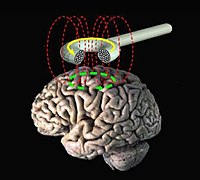
Photo from wikipedia
Background Behçet’s disease is a potentially fatal vasculitis disorder involving vessels in both the arterial and venous systems. Cutaneous manifestation is the most common sign in Behçet’s disease, but its… Click to show full abstract
Background Behçet’s disease is a potentially fatal vasculitis disorder involving vessels in both the arterial and venous systems. Cutaneous manifestation is the most common sign in Behçet’s disease, but its relation to disease activity and prognosis is lacking. Objective Our study aims to determine the relationship between cutaneous, extracutaneous manifestations with Behçet’s disease activity, morbidity, and mortality. Materials and Methods Patients diagnosed with Behçet’s disease were identified by using the 1990 International Study Group for Behçet’s disease criteria and/or the 2014 international criteria for Behçet’s disease. Data regarding patients’ clinical manifestations, laboratory results, disease activity, and prognosis were retrieved and analyzed. Disease activity was evaluated using the 2006 Behçet’s disease current activity form (BDCAF). Results Of 119 patients, the mean age at diagnosis was 35.7 ± 10.7 years and 60% were female. Median disease duration was 96 months (IQR 48–168). Minor oral ulcer at the buccal mucosa was associated with lower median BDCAF score (p = 0.003), whereas minor oral ulcer at the tonsil was related to higher BDCAF score (p = 0.024). Male gender was associated with higher cumulative dose of corticosteroids (p = 0.003) and hospitalization (OR = 2.89 (95% CI [1.10, 7.57]), p = 0.031). Ocular manifestations were related to higher dose of corticosteroids (p = 0.002) and morbidity (OR = 4.39 (95% CI [1.57, 12.29]), p = 0.005). Conclusion Our study suggests that different locations of minor oral ulcers help predict disease activity. Male gender and the presence of ocular manifestations resulted in less favorable outcomes for Behçet’s disease.
Journal Title: Clinical, Cosmetic and Investigational Dermatology
Year Published: 2020
Link to full text (if available)
Share on Social Media: Sign Up to like & get
recommendations!